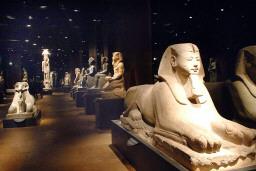A sweeping new exhibition in a legendary Rome venue explores the centuries-old love affair between the two ancient civilizations of Egypt and Rome.
The exhibit at Castel Sant'Angelo, features a host of artefacts exploring the development of ties between the land of the Nile and Rome, from the first century BC through to the Age of the Enlightenment.
The show takes as its starting point the Battle of Actium in 31 BC, which marked the defeat of the combined forces of Mark Anthony and Cleopatra at the hands of Octavian.
Following this defeat, Egyptian treasures began flowing into Rome, starting with the first obelisks, a number of which are still standing today.
This marked the beginning of a fascination with the Ancient Egyptian civilization, which would endure for centuries to come. It shaped the development of culture in Rome through Humanism, the Renaissance, the Baroque and the Enlightenment, by which time the Eternal City itself had faded to a remnant of its former power and glory.
The exhibit opens by comparing a series of depictions of historical figures in Egyptian and Classical Roman style, with busts of the emperors Nero and Domitian.
There are also several representations of Antinous, a beautiful young man beloved of Hadrian, who drowned in the Nile and was deified by the emperor after his death.
The pieces on display include a celebrated full-body sculpture known as the Antinous Farnese, on loan from the Naples Archaeological Museum, a sculpture of Antinous as Osiris, the Egyptian god of life, death and fertility, on loan from the Vatican Museum, and a beautiful red stone bust from the Dresden Museum.
One of the oldest surviving figures of the Egyptian goddess of fertility and motherhood Isis, a terracotta statue from the 1st century BC, documents the arrival of eastern religions in Rome following the defeat of Anthony and Cleopatra.
Also from this era are a splendid red marble sculpture of a priest and an enigmatic statue of Osiris in his guise as the ruler of time, on loan from the National Museum of Rome.
The allure of Ancient Egypt persisted into the Middle Ages and is charted here by a variety of art forms.
In addition to Egyptian-style lions and sphinxes, the exhibit includes the famous Tabula Bembina, returning to the Italian capital for the first time since the 1527 Sack of Rome. During Renaissance times, the bronze, inlaid table stood in the papal court and appeared in numerous drawings that were later used by Pinturicchio for his frescos of the Borgia apartments in the Vatican.
The section devoted to the 1600s features sweeping paintings of Roman landscapes featuring Egyptian pieces by the French artist Nicolas Poussin, as well as works from collections belonging to the first great Egyptologist, Athanasius Kircher.
This section will also offer visitors the first-ever opportunity to see the so-called black basalt ''magic statue'', whose two fragments are owned separately, reunited as a single piece.
The exhibit concludes with the Enlightenment and the celebrated etchings of Giovanni Battista Piranesi.
La Lupa e la Sfinge. Roma e l'Egitto dalla Storia al Mito (The She-Wolf and the Sphinx. Rome and Egypt from History to Myth) runs until November 9.










